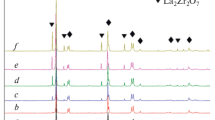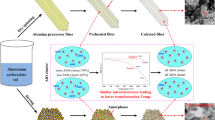Abstract
Polycrystalline zirconia fibers with dense surface and good flexibility were achieved from polyaceticzirconium (abbreviated as PEZ) precursor fibers followed by steam pretreatment and post-calcination. PEZ was synthesized via a one-pot solid–liquid reaction between basic zirconium carbonate and glacial acetic acid in methanol. Rheological behavior of the precursor sol with different concentrations was investigated, the power law model was used to describe the rheological behavior more accurately, and the relationship between the rheology and the spinnability of sol was discussed particularly. For the polymeric structure of PEZ, acetic acid was used as chelating agent and the carboxyl group was acted as a bidentate bridging ligand, which was speculated by FT-IR analysis. The effect of the pretreatment atmosphere on the evolution of the precursor fibers and the microstructure of the final fibers was discussed. The acetate group was removed in the form of molecules, and the final fibers preheated under steam atmosphere had better densification and flexibility than those were not. In addition, crystallization process, phase composition and thermal decomposition were investigated by XRD, Raman spectra and TG/DSC.
Graphical Abstract
The preheated atmosphere exerts an important influence on the densification and flexibility of zirconia fibers. Under steam atmosphere, acetate group in the precursor fibers is removed in the form of molecules and zirconia fibers sintered at 1050 °C for 2 h have a dense surface. However, zirconia fibers not subjected to the steam pretreatment have a large number of voids on the surface due to the decomposition of the organics. Furthermore, the fibers preheated under steam atmosphere have better flexibility than those were not. Therefore, pretreatment under steam atmosphere is essential for the preparation of the dense and flexible fibers.










Similar content being viewed by others
References
Miura N, Jin H, Wama R, Nakakubo S, Elumalai P, Plashnitsa VV (2011) Novel solid-state manganese oxide-based reference electrode for YSZ-based oxygen sensors. Sens Actuators B Chem 152:261–266
Abakevičienė B, Žalga A, Tautkus S, Pilipavičius J, Navickas E, Kareiva A, Tamulevičius S (2012) Synthesis of YSZ thin films by the novel aqueous sol-gel citrate-precursor method. Solid State Ion 225:73–76
Courtin E, Boy P, Piquero T, Vulliet J, Poirot N, Laberty-Robert C (2012) A composite sol–gel process to prepare a YSZ electrolyte for solid oxide fuel cells. J Power Sources 206:77–83
Jiménez-Borja C, Matei F, Dorado F, Valverde JL (2012) Characterization of Pd catalyst-electrodes deposited on YSZ: influence of the preparation technique and the presence of a ceria interlayer. Appl Surf Sci 261:671–678
Limarga AM, Shian S, Baram M, Clarke DR (2012) Effect of high-temperature aging on the thermal conductivity of nanocrystalline tetragonal yttria-stabilized zirconia. Acta Mater 60:5417–5424
Yogo T (1990) Synthesis of polycrystalline zirconia fibre with organozirconium precursor. J Mater Sci 25:2394–2398
Abe Y, Kudo T, Tomioka H, Gunji T, Nagao Y, Misono T (1998) Preparation of continuous zirconia fibres from polyzirconoxane synthesized by the facile one-pot reaction. J Mater Sci 33:1863–1870
Takahiro G, Hiroshi Y, Takaaki H, Kyoko BK, Yoshimoto A (2000) Preparation of polyzirconoxane from zirconium oxychloride octahydrate and ethylene glycol as a precursor for zirconia ceramics. Appl Organomet Chem 14:119–126
Li J, Jiao X, Chen D (2007) Preparation of Y-TZP ceramic fibers by electrolysis-sol–gel method. J Mater Sci 42:5562–5569
Li J, Jiao X, Chen D (2007) Preparation of Zirconia fibers via a simple aqueous sol–gel method. J Dispers Sci Technol 28:531–535
Abe Y, Tomioka H, Gunji T, Nagao Y, Misono T (1994) A one-pot synthesis of polyzirconoxane as a precursor for continuous zirconia fibres. J Mater Sci Lett 13:960–962
Pullar RC, Taylor MD, Bhattacharya AK (2001) The manufacture of partially-stabilised and fully-stabilised zirconia fibres blow spun from an alkoxide derived aqueous sol-gel precursor. J Eur Ceram Soc 21:19–27
Lu Q, Chen D, Jiao X (2002) Preparation and characterization of dense Pb1−xLaxTiO3 (x = 0.0–0.2) fibers through the sol-gel-related solvothermal process. J Mater Chem 12:687–690
Zhang H, Hang Y, Qin Y, Yang J, Wang B (2014) Synthesis and characterization of sol–gel derived continuous spinning alumina based fibers with silica nano-powders. J Eur Ceram Soc 34:465–473
Tsai MT (2002) Effects of hydrolysis processing on the character of forsterite gel fibers. Part I: preparation, spinnability and molecular structure. J Eur Ceram Soc 22:1073–1083
Zhu LY, Yu G, Wang XQ, Xu D (2009) Preparation and characterization of TiO2 fiber with a facile polyorganotitanium precursor method. J Colloid Interface Sci 336:438–442
Liu HY, Hou XQ, Wang XQ, Wang YL, Xu D, Wang C, Du W, Lü MK, Yuan DR (2004) Fabrication of high-strength continuous zirconia fibers and their formation mechanism study. J Am Ceram Soc 87:2237–2241
Liu H-Y, Chen Y, Liu G-S, Pei S-G, Liu J-Q, Ji H, Wang R-D (2013) Preparation of high-quality zirconia fibers by super-high rotational centrifugal spinning of inorganic sol. Mater Manuf Process 28:133–138
Sacks MD, Sheu R-S (1987) Rheological properties of silica sol-gel materials. J Non Cryst Solids 92:383–396
Sakka S, Kamiya K (1982) The sol-gel transition in the hydrolysis of metal alkoxides in relation to the formation of glass fibers and films. J Non Cryst Solids 48:31–46
Kamiya K, Yoko T (1986) Synthesis of SiO2 glass fibres from Si(OC2H5)4-H2O-C2H5OH-HCl solutions through sol–gel method. J Mater Sci 21:842–848
Kozuka H, Kuroki H, Sakka S (1988) Flow characteristics and spinnability of sols prepared from silicon alkoxide solution. J Non Cryst Solids 100:226–230
Wolf C, Rüssel C (1992) Sol–gel formation of zirconia: preparation, structure and rheology of sols. J Mater Sci 27:3749–3755
de Sá Costa B, dos Reis Coimbra JS, Martins MA, Garcia-Rojas EE, Telis-Romero J, De Oliveira EB (2013) Rheological behavior of binary aqueous solutions of poly(ethylene glycol) of 1500 g mol−1 as affected by temperature and polymer concentration. J Chem Eng Data 58:838–844
Zhang LM, Zhou JF, Hui PS (2005) Thickening, shear thinning and thixotropic behavior of a new polysaccharide-based polyampholyte in aqueous solutions. Colloids Surf A 259:189–195
Yang H, Ruan J, Zou J, Wu Q, Zhou Z, Zhou Z (2009) Rheological responses of fumed silica suspensions under steady and oscillatory shear. Sci China Ser E Technol Sci 52:910–915
Raghavan SR, Khan SA (1997) Shear-thickening response of fumed silica suspensions under steady and oscillatory shear. J Colloid Interface Sci 185:57–67
Shao P, Qin M, Han L, Sun P (2014) Rheology and characteristics of sulfated polysaccharides from chlorophytan seaweeds Ulva fasciata. Carbohydr Polym 113:365–372
Deacon GB, Phillips RJ (1980) Relationships between the carbon-oxygen stretching frequencies of carboxylato complexes and the type of carboxylate coordination. Coord Chem Rev 33:227–250
Gazzoli D, Mattei G, Valigi M (2007) Raman and X-ray investigations of the incorporation of Ca2+ and Cd2+ in the ZrO2 structure. J Raman Spectrosc 38:824–831
Uma Maheswari A, Mohan SR, Saravana Kumar S, Sivakumar M (2014) Phase tuning of zirconia nanocrystals by varying the surfactant and alkaline mineralizer. Ceram Int 40:6561–6568
Herrera G, Montoya N, Domenech-Carbo A, Alarcon J (2013) Synthesis, characterization and electrochemical properties of iron-zirconia solid solution nanoparticles prepared using a sol-gel technique. Phys Chem Chem Phys 15:19312–19321
Li M, Feng Z, Ying P, Xin Q, Li C (2003) Phase transformation in the surface region of zirconia and doped zirconia detected by UV Raman spectroscopy. Phys Chem Chem Phys 5:5326–5332
Xu G, Zhang Y-W, Han B, Li M-J, Li C, Yan C-H (2003) Unusual calcination temperature dependent tetragonal–monoclinic transitions in rare earth-doped zirconia nanocrystals. Phys Chem Chem Phys 5:4008–4014
Xu G, Zhang Y-W, Liao C-S, Yan C-H (2004) Doping and grain size effects in nanocrystalline ZrO2–Sc2O3 system with complex phase transitions: XRD and Raman studies. Phys Chem Chem Phys 6:5410–5418
Quintard PE, Barbéris P, Mirgorodsky AP, Merle-Méjean T (2002) Comparative lattice-dynamical study of the raman spectra of monoclinic and tetragonal phases of zirconia and hafnia. J Am Ceram Soc 85:1745–1749
Acknowledgments
The authors acknowledge the financial support of the National Natural Science Foundations of China (Grant Nos. 51472144, 51372140 and 51102155), the Fundamental Research Funds of Shandong University (Grant No. 2015JC022) and the Youth Scientist Fund of Shandong Province (BS2011CL025).
Author information
Authors and Affiliations
Corresponding authors
Rights and permissions
About this article
Cite this article
Liu, H., Liu, B., Wang, X. et al. Rheological behavior, molecular structure of precursor and evolution mechanism: zirconia fibers from polyaceticzirconium precursors. J Sol-Gel Sci Technol 76, 482–491 (2015). https://doi.org/10.1007/s10971-015-3797-y
Received:
Accepted:
Published:
Issue Date:
DOI: https://doi.org/10.1007/s10971-015-3797-y




